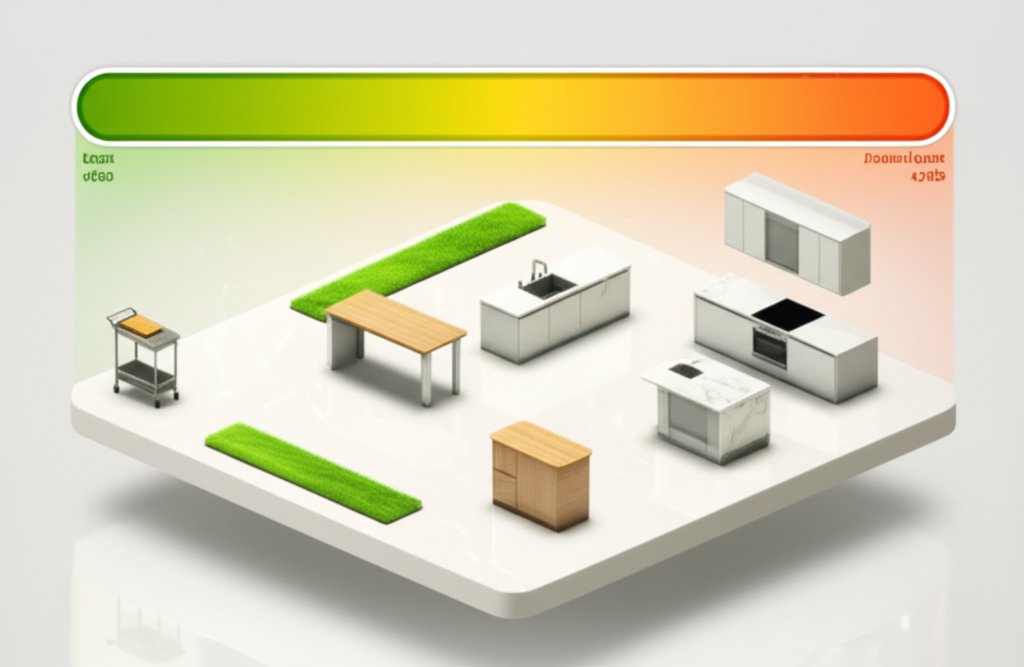Dreaming of a kitchen island? You’re not alone! But before you get too far into Pinterest boards, let’s talk about the real elephant in the room: how much is a kitchen island really going to cost? It’s a question with a surprisingly wide range of answers, from a few hundred dollars for a basic rolling cart to upwards of $10,000 or more for a custom-built masterpiece.
At a glance:
- Understand the key factors that impact kitchen island price.
- Decide whether pre-fabricated, semi-custom, or fully custom is right for your budget.
- Learn how to estimate hidden costs like electrical, plumbing, and permits.
- Get a realistic idea of installation costs based on DIY vs. professional help.
- See budget-friendly alternatives to get the island you want without breaking the bank.
The Kitchen Island Cost Spectrum: From Cart to Custom
The biggest factor influencing how much you’ll spend is the type of island you choose. Think of it as a spectrum with rolling carts on one end and fully custom islands on the other.
- Rolling Carts: These are your budget champions, ranging from $150 to $900. Think extra counter space and storage on wheels. Perfect if you’re renting or need flexibility.
- Prefabricated Stationary Islands: Step up in price and functionality, costing $900 to $5,000. These offer more storage and often feature drawers and shelving.
- Custom-Built Islands: The sky’s the limit! Expect to pay $3,000 to $6,000 on average, but costs can easily exceed $10,000 for larger, more complex designs with high-end materials and special features.
But sticker price is only part of the story.
Beyond the Base Price: Hidden Costs to Consider
It’s crucial to factor in potential hidden costs that can significantly increase your overall expense.
- Countertop Material: Natural stone like granite or marble costs considerably more than laminate or butcher block. A granite kitchen island cost can range from $75 to $200+ per square foot including fabrication and installation.
- Electrical & Plumbing: Adding outlets (and you likely need to; the National Electric Code requires at least one outlet for islands larger than 2’x1’) or a sink skyrockets the price.
- Installation: Labor can add a hefty chunk to the total. A handyperson’s hourly rate is often $50 to $150 per hour.
- Permits: Any major kitchen renovation will require one, and depending on your municipality, you might also need one if you install new plumbing or electrical work.
- Design Fees: Engaging a professional kitchen designer can range from $4,300 to $30,000, especially for major renovations.
Let’s break down some specific scenarios.
Real-World Examples: Kitchen Island Cost Scenarios

To illustrate the range of costs, here are a few examples:
Scenario 1: Budget-Friendly Rolling Cart Upgrade
- Goal: Add extra counter space and storage to a small apartment kitchen.
- Solution: Purchase a sturdy rolling cart with a butcher block top and locking casters.
- Estimated Cost: $400 – $800
- Installation: DIY.
Scenario 2: Semi-Custom Island with Seating - Goal: Create a functional island with seating in a medium-sized kitchen.
- Solution: Purchase a semi-custom island from a cabinet manufacturer, choosing a quartz countertop and bar-height seating.
- Estimated Cost: $3,500 – $6,000 (including installation)
- Installation: Professional.
Scenario 3: High-End Custom Island with All the Bells and Whistles - Goal: Design a statement island with integrated appliances, a prep sink, and high-end finishes.
- Solution: Work with a custom cabinet maker and interior designer to create a bespoke island with a waterfall countertop, built-in dishwasher, and wine fridge.
- Estimated Cost: $12,000+ (including design fees, installation, and appliances)
- Installation: Professional, requiring multiple trades (plumber, electrician, carpenter).
DIY vs. Professional Installation: Making the Call
One significant way to control costs is by considering DIY installation.
- DIY Advantages: Save on labor costs (roughly $40 to $140 per hour), gain satisfaction from completing the project yourself.
- DIY Disadvantages: Requires skills and time, potential for mistakes, may void warranties on certain components.
- Professional Advantages: Ensures proper installation, compliance with building codes, saves time and effort.
- Professional Disadvantages: Higher cost, requires scheduling and coordination.
Decision Point: If you’ve purchased a straightforward prefabricated kitchen island and have some home remodeling chops, you can take on the challenge of building a kitchen island yourself. If your island involves plumbing or electrical work, it’s highly recommended to hire professionals for those aspects to ensure safety and compliance with building codes.
Countertop Considerations: A Major Cost Driver
The countertop material is a major factor in your overall budget. Here’s a quick rundown:
| Material | Cost per Square Foot (Installed) | Pros | Cons |
|---|---|---|---|
| Laminate | $20 – $50 | Affordable, wide range of colors and patterns | Not as durable, can be susceptible to scratches and heat damage |
| Butcher Block | $50 – $150 | Warm, natural look, can be sanded and refinished | Requires regular maintenance, susceptible to water damage |
| Quartz | $80 – $225+ | Durable, low maintenance, wide range of colors and patterns | Can be expensive |
| Granite | $75 – $200+ | Natural stone, durable, adds value to your home | Requires sealing, can be porous, limited color and pattern options |
| Marble | $100 – $250+ | Luxurious look, classic appeal | Porous, susceptible to staining and scratching, requires significant care |
| Before making any final decisions, it is important to research kitchen island price factors explained, and all of the nuances of your project to ensure that you are making the best decision for your budget. |
Square Footage Costs: How Big Is Too Big (or Too Small)?

As you’ll see throughout this cost guide, virtually every aspect of your kitchen island installation will have costs based on a per-square-foot or per-linear-foot basis, which means larger kitchen islands will always cost more while keeping materials and quality similar.
You can use the average cost per square foot for a kitchen island — around $200 — to get an idea of what your installation costs will be without using a kitchen island cost calculator. Keep in mind that your kitchen island dimensions should be based on your kitchen size and layout, so be sure to come up with adequate measurements before estimating your island installation cost.
Quick Answers: Common Questions About Kitchen Island Costs
- Q: Does a kitchen island add value to my home?
- A: Yes! A kitchen island’s extra counter space, beauty, and functionality will likely impress potential home buyers. You can expect an ROI of about 60% to 80% of the cost of your kitchen island installation.
- Q: Do I need a permit to install a kitchen island?
- A: It depends. Simple installations without plumbing or electrical work usually don’t require one. However, if you’re adding new plumbing or electrical lines, you’ll likely need a permit. Check with your local building department or ask your contractor to find out what’s required in your area. Permit costs can range from $460 to $2,900, depending on the permits required.
- Q: Is it cheaper to buy a pre-fab island or build my own?
- A: Generally, pre-fabricated islands are less expensive upfront, especially if you opt for a rolling cart. However, building your own allows for customization and potentially higher-quality materials (if you’re skilled).
- Q: What are the most expensive features to add to a kitchen island?
- A: Plumbing (sinks, dishwashers), electrical (outlets, appliances), high-end countertops (marble, exotic granite), and custom cabinetry. Waterfall islands that give the appearance of being manufactured from a single stone add at least $1,000 to the overall price, as this type requires a computer-controlled laser cutter.
- Q: Can I add a cooktop to my kitchen island?
- A: Yes, but you will need the proper gas or electric lines running to the island. You will also need to factor in the costs of a range hood, also known as an extractor.
Your Kitchen Island Playbook: A Step-by-Step Guide
Ready to start planning? Here’s a practical playbook:
- Define Your Needs: What will you primarily use the island for (prep, cooking, seating, storage)?
- Measure Your Space: Ensure adequate clearance around the island (at least 36-42 inches).
- Set a Budget: Be realistic and factor in potential hidden costs.
- Explore Options: Research pre-fabricated, semi-custom, and custom islands, weigh the advantages and disadvantages of each.
- Get Quotes: Obtain multiple quotes from contractors, cabinet makers, and countertop suppliers.
- Finalize Design: Select materials, finishes, and features.
- Obtain Permits: If necessary, apply for the required building permits.
- Schedule Installation: Coordinate with contractors and tradespeople.
- Enjoy Your New Island!
Take Your Next Step: Actionable Insights
Ultimately, figuring out how much a kitchen island will cost requires careful planning and research. By understanding the key factors that influence price, exploring your options, and getting realistic quotes, you can create a beautiful and functional island that fits your budget and lifestyle. Don’t be afraid to get creative and explore budget-friendly alternatives! A well-planned island is an investment that can transform your kitchen and enhance your home’s value.
- Gray And White Backsplash: Ideas For Timeless Style - December 12, 2025
- Gray Kitchen Backsplash Ideas: Find Your Perfect Gray Tile - December 11, 2025
- Glass Wall Tiles For Bathroom: A Stylish, Durable Choice - December 10, 2025









